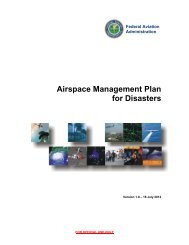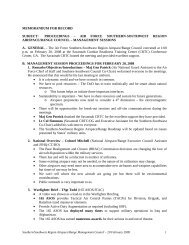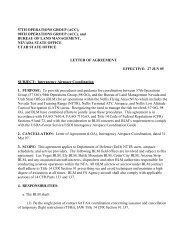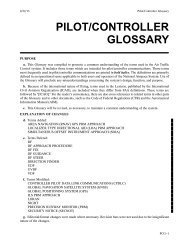North Ops Airspace Deskguide - Interagency Airspace Coordination
North Ops Airspace Deskguide - Interagency Airspace Coordination
North Ops Airspace Deskguide - Interagency Airspace Coordination
Create successful ePaper yourself
Turn your PDF publications into a flip-book with our unique Google optimized e-Paper software.
11. 0900 hours: Participate in Aviation briefing at Airtanker Base vehicle parkingbay. Attendance is typically pilots and Incident personnel. Provide airspaceupdates and briefing of TFR status and associated issues, concerns,clarifications etc. During this briefing solicit feedback concerning productsand <strong>Airspace</strong> Coordinator support.12. 1500 hours: Participate in Area Command conference call.Phone number:Passcode:13. 1730 hours: Participate in Aviation conference call.Phone number:Passcode:14. End of Day: Provide a correction map of all TFR changes to GIS for inclusiononto the Relief Map.Recurring Tasks15. TFR Tools and Procedures: TFR numbers, complexity and frequency within<strong>North</strong>ern California results in a very high operating tempo. To facilitate,organization and efficiency in handling the multitude of requests several toolsmay be of assistance to the <strong>Airspace</strong> Coordinator. These are not mandatory andthe GACC or individual coordinators may prefer using different tools. However,use of the attached documents or something similar is recommended:• TFR Action Checklist (attachment 2): used to track receipt, analysis,issuance, changes and cancellations of individual TFRs. This list is normallykept in the front of a folder for each incident TFR.• TFR Progression list (attachment 3): This list is valuable in keeping arunning summary of all TFR actions by number, name, Notam #, Order and Anumber and frequency.• TOPO USA: This tool assists the <strong>Airspace</strong> Coordinator to provide quick-timefeedback to the field for TFR questions and analysis. High quality graphicscan be e-mailed or immediately printed for use and display. Also, thismapping tool provides the <strong>Airspace</strong> Coordinator a quick Big Picture status ofall TFRs within the zone.o Setting up TOPO USA (Version 7.0): TOPO can be used toassist the airspace coordinator (ASC) track TFR changes,display potential conflicts (2-D and/or 3D), and provide displayoptions to print and e-mail when constructing TFRs. Using themaps, the <strong>Airspace</strong> Coord. can also determine distances toclosest reload base, which is required on the NES entering ofthe TFRs in <strong>North</strong> <strong>Ops</strong> area. Items which are helpful to insertinto the Base project TOPO map are: Tanker Bases (obtainedfrom the <strong>Interagency</strong> Air Tanker Base Guide), airports (fromH:\Expanded Aircraft 4
AIRNAV, Flight Guide or local dispatch information), currentmajor helibases in use, Special use <strong>Airspace</strong> (from AP1B) ifapplicable and any local geographic points utilized by incidentaircraft. By using the SNAGIT program (can be downloaded topersonal laptop on 30 day free trial), the <strong>Airspace</strong> Coord. isalso able to quickly put and insert views of proposed TFRlocations into a word document which is then easily e-mailed.Or you can use “Print Screen” and the Paint Program for thesame cut and paste type thing.• ROSS Support: The airspace coordinator inputs the TFR “Fill” informationinto the ROSS program once a TFR NOTAM is published and a number isassigned.o TFR Daily Cancellation List (attachment 4): Given to theAircraft Coordinator nightly, this list quickly assists the timelyclosure of released TFRs through ROSS.o New TFR list: Given to the Aircraft Coordinator so the InitialAttack Aircraft board can be updated.16. Daily or more often: Check for new e-mail.E-mail address: (whatever-email-address)Password:(whatever-password)17. Daily or as needed: Check with Frequency Coordinator (If there is oneassigned to the GACC, if not check with the Aircraft Coord. to ensure air-to-airfrequencies listed on the TFRs are appropriate.18. Every 1-2 days call RDD Tower 221-4475 and ascertain the opportunity /needfor them to receive a small copy of the latest NOTAM map. Discuss anyproblems that TFRs may be causing and facilitate any necessary fixes withAOBD.19. As appropriate or at end of day: Make entries in and update the daily worklog. Be sure information is sufficiently detailed to “build” an end-of-assignmentreport for Julie and the GACC.20. On Forest Service computer use NOTAM Entry System (NES) to create andmodify TFR NOTAMs.NES initials: Obtain from Aircraft Coord.NES password: Obtain from Aircraft Coord.Oakland Center (KZOA) 510-475-3331Seattle Center (KZSE) 253-351-3520Los Angeles Center (KZLA) 661-265-8205You may apply for your own NES “initials” and password. You may feel this may not beworth it. (To register on NES with your own name, initials and password, see note, below.)H:\Expanded Aircraft 5
MiscellaneousCheck with Aircraft Coordinator first. To register in ‘NES with your own name, initials andpassword:• Use a computer which already has an NES Certificate loaded into it. (The Forest Servicecomputer used by <strong>Airspace</strong> <strong>Coordination</strong> has it. Aircraft Coordinator will know whichother(s) have it, also.)• Go into NES website.• In the “Client Authentication” dialog box, click “OK”• In “Security Alert” dialog box, click “Yes”• In left-hand column, click on “Register User”• Follow instructions on screen. (This includes calling NES office to active your password.)Computer File “tree” Set this up if not already done.My Documents (folder)AIRSPACE (folder)Sub folder Pilot BriefingNOTAMs (folder)Advisory NOTAMs (folder)Boundary Zones (folder)Folder to Store Downloads (folder)UAV (folder)Last-task of evening: Turn off the Forest Service computer… and the lights!The NOPS Aircraft Coordinator has access into the NOTAM system. This is to createNOTAMS for Smokejumper Practice Jumps. If needed you maybe asked to create aNOTAM for “Parachute Exercises”. See the Aircraft Procedures guide for this and thelogins. Rights have only been given to NOPS to create these for RDD, FAT and SBD.H:\Expanded Aircraft 6
ATTACHMENT 1<strong>Airspace</strong> Coordinator Roles (updated 2008)By Julie Stewart<strong>Airspace</strong> <strong>Coordination</strong> Specialist (THSP)May be ordered to assume or assist with airspace duties within a GACC. An <strong>Airspace</strong>Coordinator Specialist should be ordered when incident activity is widespread and involves anumber of complex TFRs, complex airspace is involved or difficult conflict resolutions exist withvarious agencies. Many GACCS request an <strong>Airspace</strong> Coordinator when they have six or moreTFRs in their geographic area.This position is ordered as a technical specialist (THSP). <strong>Airspace</strong> <strong>Coordination</strong>Specialists can function in a variety of situations and at various levels within theorganization. Please designate the level of expertise when ordering (i.e. Field,GACC, Local, Support).1. Field <strong>Airspace</strong> Coordinator SpecialistOrdered to assist with airspace coordination in the field among Area Commands, IncidentManagement Teams, Dispatch organizations, local airports, general aviation, FAA offices andDoD office. Must have extensive aviation experience coordinating airspace issues, excellentoperational knowledge of the field ICS organization (i.e. AOBD position), along with excellentpersonal communication skills.2. GACC <strong>Airspace</strong> Coordinator SpecialistOften located at a GACC and supports airspace activity within a GACC boundary. Requiresextensive aviation and dispatch background to facilitate coordinating activity. ICS aviationexperience, knowledge and communications skills are mandatory at this level.3. Local Unit <strong>Airspace</strong> Coordinator SpecialistSupports airspace activity within a local unit and can often assume airspace coordination dutiesrelieving local unit dispatchers so they can concentrate on initial attack and large incidentsupport. Often has Initial attack background as a dispatcher. Requires extensive aviation anddispatch background to facilitate coordinating activity. ICS aviation experience, knowledge andcommunications skills are mandatory at this level.4. <strong>Airspace</strong> <strong>Coordination</strong> Specialist SupportPositions to support the airspace program. Must have knowledge of various aviation programsto support the <strong>Airspace</strong> Coordinator Specialist. Could be a webmaster, computer programer,GIS specialist, Mapping specialist or likewise.The <strong>Airspace</strong> Coordinator has responsibility to:1. Plot all current TFRs on sectionals. Assess situations involving:• Classes of <strong>Airspace</strong>• Airport Approaches and DeparturesH:\Expanded Aircraft 7
• Flight Schools, Sky Diving Schools• Congested <strong>Airspace</strong>, Special Use <strong>Airspace</strong>, MTRs, and unpublished airspace situations• Cruise Missile Routes2. Contact involved ARTCC’s with assessment of incident situation and discuss airspacecoordination and TFR procedures.3. Coordinate the ordering of TFRs with Dispatch. TFRs ordering will involve an AircraftResource Order for document purposes. Maintain a log of ALL airspace discussions (for legalpurposes). <strong>Airspace</strong> coordinator will maintain documentation.4. Distribute current TFRs to Incident Management Team’s aviation operations. Discuss sizeand altitudes involved.5. Coordinate the combining of TFRs when they overlap. Non-circular TFRs are acceptablewhen coordinated with FAA ARTCC and are described in such a way that the U.S. NOTAMoffice can publish them. Ask AOBDs to modify airspace on a timely basis, particularly if they candownsize the area or lower the ceiling.6. Obtain copies of any <strong>Airspace</strong> Agreements involving land managementagencies and military bases. Contact Scheduling Activities (MTRs) or Controlling Agencies(SUAs) with maps of current TFRs. Provide briefing, discussing airspace deconfliction andprocedures for handling intrusions.7. Obtain copies of TFRs (FDC NOTAMS) from DINS (Department of Defense Internet NOTAMSystems( located at the US NOTAM office. Carefully check published NOTAMs with TFRrequests and verify that they are accurate with no typographical errors. Check NOTAMs on adaily basis.8. Brief incoming Area Commands, Incident Management Teams, ATGSs and any otherassigned pilots on the current TFRs and known airspace hazards.9. Coordinate with other agencies. Non-participating agencies often have to continue their workand will be in contact to ask for permission to fly within the TFR. Provisions are alreadyestablished for media and Law Enforcement entry. Establish contact with respective AirOperations Branch Director and coordinate the agencies request for entry (i.e. mosquitospraying, highway survey, etc.).Non-participating aircraft should only be allowed into a TFR when it is feasible, safe andpreviously coordinated so that frequencies are shared.10. Receive reports of any intrusions. Take immediate action with ARTCC and or MilReps andScheduling Activities/Scheduling Agencies. If the intruder is Military, ask for assistance from theMilitary Operations Specialist (MOS) at the Area Managers desk at ARTCC.11. Assure that a SAFECOM be filed for any airspace intrusions. Follow through with FAA,DOD, Media or AOPA contacts on an as needed basis.12. Adjust TFRs on an as needed basis (after conferring with the appropriateAir Operations Branch Director). Credibility and good faith will be established if airspace is givenback to the FAA when it is no longer needed. Coordinate the establishment of “day time” TFRswhen feasible.13. Coordinate publishing a list of daily TFRs in the Air OperationsH:\Expanded Aircraft 8
Plan and or GACC Sit report if requested. . The list may include: NOTAM number, VOR/DME,ALT, Radius, Latitude/Longitude, and Incident Name.14. Coordinate requests for temporary towers. Coordinate any staffingissues with FAA, AOBD and dispatch.During extremely complex situations, the <strong>Airspace</strong> Coordinator may find itappropriate to:1. Contact FAA Regional <strong>Airspace</strong> Branch Manager with executivebriefing and ask for assignment of a FAA Regional HeadquartersLiaison.2. As necessary, brief daily with TFR depictions and assessments:• ARTCC, FSDO, FSS• Appropriate FAA Towers and involved airports• MilReps (AFREP, NAVREP, DARR, ATREP, etc.)• All involved DoD Bases• Air Tanker Bases, Helibases, Smokejumper, Rappel Bases• Incident Management Teams (All Air <strong>Ops</strong> Branch Directors)• GACCs and Dispatch Centers• National Broadcasting Pilots Association (NBPA)• AOPA Regional Rep or AOPA Pilot Hotline3. Contact local NBPA members and assess media coordination regarding TFRs.4. Contact AOPA national office or regional representative with briefing.Establish coordination with AOPA Pilot Hotline and daily briefings with AOPA.5. If needed, ask FAA Regional Headquarters Liaison if the FAA will issue a press releaseidentifying TFRs and the need for General Aviation pilots to remain away from the incident area.6. Presidential and Vice Presidential visits will be coordinated through the local ARTCC andassigned FAA Regional Headquarters Liaison. The FAA will coordinate the issuance of the 14CFR 91.141 TFR.7. Discuss the 1255 Transponder Code with the FAA. Assure that local FAA is aware oftransponder frequency. If they are unaware, share documentation of assignment and fax info tolocal towers and ARTCCs.8. Coordinate mailing of airspace or TFR posters to all incidents andinvolved airports with an attached letter discussing the safety aspectsof staying away from TFRs.H:\Expanded Aircraft 9
Date ___________TFR ACTION CHECKLISTISSUANCE:______ Request in ROSS & Fax received from dispatch office_____ Lat X Long_____ Air to Air Freq_____ Altitude (normal 2,000 above highest terrain)_____ Radius or corners noted_____ Descriptive information______ Initiation of TFR folder______ Determination if revision of previous TFR______ Determination if 24 hour or daily (hours of operation)______ AP1B review completed______ Sectional Map review completed______ Military airspace de-conflicted / contacted______ Mapped on TOPO and options/cautions discussed with AOBD(s) if issues______ Enter information into NES and save. Review for edits, print draft withauthor’s comments.______ Submitted to ARTCC/ followed by phone call to confirm receipt______ Review official NOTAM, noting number and time issued______ Fill information entered into ROSS______ Notify unit and GACC Aviation Coordinator and Forest/Unit that TFR hasbeen issued.______ Print TFR with map and place in labeled folder.______ Place information on the daily “UPDATE MAP” to GIS specialist.CANCELLATION:_____ Cancellation request received from dispatch office_____ TFR cancelled via phone call to ARTCC_____ Confirm TFR cancellation to Forest/unit & GACC Coordinator_____ Cancellation documented in TFR folder_____ TOPO map updated_____ Provide information on cancellation to GIS specialistH:\Expanded Aircraft 10
ATTACHMENT 3 (EXAMPLE)` <strong>North</strong>ern California TFR Progression starting 7/20/08IncidentDate Name Notam# Order number A-# Altitude Radius/shape Frequency7/20 Carey fire 8/8533 CA-SHF-1057/ A-103 10000 3NM 136.025H:\Expanded Aircraft 11
Attachment 4Cancelled TFRsNEED RELEASED IN ROSSDate:_________TFR # INCIDENT NAME INCIDENT CODE A-NUMBER8/8490 SODA CA-MNF-000645 A-84H:\Expanded Aircraft 12
Attachment 5Phone List for NOPS areaOFFICE GREEN ATSS FTS FIRE PHONE(530)BTU - (Oroville-Butte Unit) 301 401 201 501 538-6460LMU- (Susanville-Lassen-Modoc(530)Unit) 302 402 202 502NEU- (Grass Valley-Nevada-Yuba-Placer Unit) 303 403 203 503SHU- (Redding-Shasta-Trinity Unit) 304 404 204 504TGU- (Red Bluff- Tehama-Glenn Unit) 305 405 205 505SKU - (Yreka-Siskiyou Unit ) 306 406 206 506CAL FIRE SAC ECC 307 407 207 507CSR ECC DAY (SOPS) 308 408 208 508CSR ECC Night (SOPS) 409 209 509CSR ECC ALT (SOPS) 410 210 510MEU- (Howard Forest-MendocinoUnit) 311 411 211 511HUU- (Fortuna-Humboldt-Del NorteUnit) 312 412 212 512AEU- (Camino-Amador-EldoradoUnit) 313 413 213 513LNU- (St Helena-Sonoma-Lake-NapeUnit) 314 414 214 514MRN- (Woodarce- Marin County) 315 415 215 515SCU- (Morgan Hill-Santa Clara Unit) 316 416 216 516CZU- (Felton- San Mateo -SantaCruz Unit) 317 417 217 517ENF-TMU (Camino- EldoradoNF/Tahoe M. Unit) 320 420 220 520H:\Expanded Aircraft 13257-5575(530)477-5764(530)225-2411(530)529-8548(530)842-7066(916)653-8360(909)320-6197(909)320-6197(707)459-7403(707)726-1280(530)647-5294(707)963-4112(415)488-4321(408)778-1893(831)335-6719(530)642-5170
ROUTE Segments Miles off Officecenter LineVR 1250 A-L 2 LEMOREVR 1251 B-G 2 LEMOREVR 1254 C-D 2 LEMOREVR 1261 B-H 2 LEMOREVR 202 B-G 2 LEMOREIR 207 H-O 5 LEMOREIR 300 B-D 4 MTN HOMESR 300 Q-U 3 TRAVISSR 301 A-E 3 TRAVISSR 311 A-F 3 MOFFETTSR353 A-G 3 MOFFETTSR 359 A-I 3 MOFFETTSR 398 A-D 3 MOFFETTMOA GOOSE/DOLPHIN 541-885-66864/08Military Training Route Quick ReferenceLemore---559-998-1034Moffett---650-603-9357Travis-----707-424-5582,1075,1073Mountain Home 208-828-2172208-828-5800 WKD & after 1530H:\Expanded Aircraft 15
















